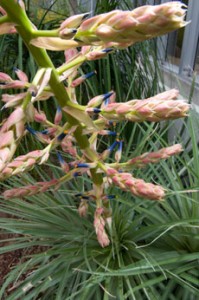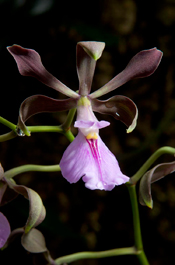 An interesting plant has come into bloom for the first time in the Arid Greenhouse. Turquoise puya (Puya alpestris) produces brilliant turquoise flowers accentuated by intensely orange anthers. The species is native to the high desert mountains of southern Chile, and obtains almost all of its water from the morning dews that briefly precipitate water before sunrise. The long, thin, arching leaves are protected by spines along the margin that discourage herbivores from taking a bite. Learn more about this and four other plants in this week’s Bloom Highlight. http://www.chicagobotanic.org/inbloom/highlight.php
An interesting plant has come into bloom for the first time in the Arid Greenhouse. Turquoise puya (Puya alpestris) produces brilliant turquoise flowers accentuated by intensely orange anthers. The species is native to the high desert mountains of southern Chile, and obtains almost all of its water from the morning dews that briefly precipitate water before sunrise. The long, thin, arching leaves are protected by spines along the margin that discourage herbivores from taking a bite. Learn more about this and four other plants in this week’s Bloom Highlight. http://www.chicagobotanic.org/inbloom/highlight.php
Category: Nature in View
Orchids are Nearing Peak Bloom in The Greenhouses

Orchids are reaching their peak in The Greenhouses. The dragon mouth orchid is native from Guatemala to Panama, where the subspecies rosea is found. This dragon mouth orchid (Encyclia cordigera var. rosea) is in the Tropical Greenhouse, lower level, east epiphyte tree. The flower spikes can produce flowers for up to three months, and each of the flowers smells like chocolate. This species requires very bright light whether grown in greenhouses, on a windowsill, or under artificial lights. During the summer growing season it prefers a moist, humid growing environment, but in the winter the watering should be reduced and diurnal — the difference between night and day low temperatures — with temperature fluctuations of 10 degrees to initiate flower production. Learn more about what’s in bloom here. http://www.chicagobotanic.org/inbloom/highlight_archive/highlight_022812.php
What’s in Bloom This Winter?
In this video, Boyce Tankersley takes us on a tour of what’s in bloom in the three Greenhouses in the Regenstein Center. We’ll learn about carnivorous plants, a Sago Palm and some giant aloe plants. He also shows us a plant that blooms outdoors even in winter. Visit http://www.chicagobotanic.org/inbloom for more information.
What’s in Bloom This Fall
Boyce Tankersley, Director of Plant Collections, takes us on a tour of the Garden to see some fall highlights. We saw the cascading mum hayracks over the Visitor Center Bridge, vibrant color combinations in the Circle Garden, developing colors on the roses in the English Walled Garden and fall color developing on trees throughout the Garden. Visit http://www.chicagobotanic.org/inbloom before your visit for a list of what’s currently in bloom. Also don’t forget to visit the What’s in Bloom Cart outside the Visitor Center for more highlights.
Blue Herons and Other Wading Birds
We visited with Jim Steffen, senior ecologist here at the Chicago Botanic Garden, to learn more about the wildlife you can find here. The Barbara Brown Nature Reserve on the south end of the Chicago Botanic Garden is just one place you can find different wading birds. Visit http://www.chicagobotanic.org/birds/species for more information on birds at the Chicago Botanic Garden.
